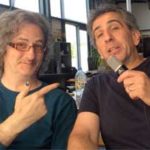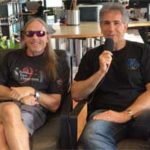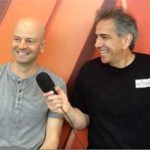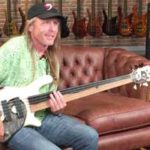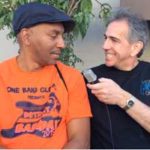Space Cowboy goes one-on-one with FGPO, sharing thoughts about his (long awaited) Rock Hall induction, playing to today’s audiences and more
By Gary Graff
April 8, 2016
Today, Steve Miller is being inducted into the Rock and Roll Hall of Fame — an honor that many, and not just the Space Cowboy’s fans, feel is long overdue. Miller will be honored for a recording career that began in 1968, but his story dates back even further, to befriending and studying at the feet of Les Paul while growing up in Milwaukee to starting to play himself while his family was living in Texas and then moving to Chicago and playing the blues scene there until he left for San Francisco in 1966.
Miller has been riding peaks and valleys of success, including a trio of mid-70s albums — The Joker, Fly Like An Eagle and Book of Dreams — that insured he can tour wherever and whenever he wants. It’s also given him license to experiment further with his albums, from the (then) high-tech of 1982’s Abracadabra to 1988’s Born 2 B Blue and the covers sets Bingo! and Let Your Hair Down in 2010 and 2011, respectively.
Even though his recorded output has slowed, Miller can talk contemporary technology like a twenty-something and he’s dedicated himself to educating future generations of musicians as an Artist in Residence at the USC Thornton School of Music and via projects with Lincoln Center For the Performing Arts in New York.
FGPO: You’re going into the Hall of Fame. How does it feel?
Miller: It was a surprise, but I’m glad they took their time and got it right. When it was first proposed and they were working on it, they were sending me blueprints of proposals for buildings and I was looking at these blueprints and making suggestions, ’cause I’ve designed lots of studios and lots of buildings and stuff. That was, what, 30 years ago? So now I’m finally getting in. Guess there wasn’t any urgency! (laughs)
FGPO: Was it a big issue to you that you weren’t?
Miller: Well, I had to wait ’til I was eligible or something and then I became eligible and then nothing happened and that sort of went on for awhile. It became kind of weird. It’s strange to have people come up to you and say, “Well, how do you feel about this?” and honestly I hadn’t even thought about it. But you have to respond to it. So then after awhile it became kind of fun ’cause every year I’d get sort of a bump around the world ’cause people were mad I wasn’t inducted or nominated that year. So every year I got that little bump.
FGPO: You had to think about it a little bit, though, no?
Miller: I sort of just got used to the idea that this isn’t going to happen or I’ll probably be dead when it happens — IF it happens. Then, just out of the clear blue, a few months ago, some people said, “Hey, you’ve been nominated for the Rock and Roll Hall of Fame and a million people just voted for you (in the public vote) this week.” I’m going, “What are you talking about?” But I’m happy to be in it. I’m happy for my fans; They’re excited about it, and I’m happy to work with (the Rock Hall) on musical education programs and things like that, things that make sense. It’s a great American art form, it’s one that lives and breathes and changes.
FGPO: And you will be sharing space with a lot of your own heroes and influences.
Miller: Oh, yeah, without a doubt. I’m honored to be in the same Hall and walk in and say “hi” to Jimmy Reed and T-Bone WAlker and Jerry Lee Lewis and people like that. That feels great. So it’s fun from that standpoint.
FGPO: You have Texas and Chicago in your background, but you really broke out of the San Francisco scene during the late ’60s. What was going on out there back then?
Miller: Well, San Francisco was the most vibrant music scene of the 20th Century. So, let’s start right there. It was a complete change of how things worked in the world and when you’re in something like that, you think it’s great. You think it’s going to last forever. You wake up one morning and it’s gone. It was really magic. Compared to the rest of the musical world that I was involved in, the rest of it was a bunch of gangsters running night clubs and stealing stuff from musicians and you worked in bars or you worked for Dick Clark. It was very goofy. San Francisco was extremely real.
As soon as I understood what was going on in San Francisco, which was in 1965 and ’66, I immediately left Chicago, where I was working in a night club that was being shaken down by the mafia and the police for payments. I mean it was a real thug world. I immediately got in my Volkswagen Bus and drove to San Francisco. When I got there what I realized was it was much, much more than just bands and music. It was a true social phenomena. I didn’t really understand that for a while because the bands when I first got to San Francisco really weren’t very good. They were guys who were folk musicians who decided they wanted to be rock stars and they bought Beatle boots and let their hair grow long and got an electric guitar and started a band. I was kind of going, “What’s going on here? They’re doing a bad version of ‘In the Midnight Hour.’ What is this?” I’d come from Chicago where Junior Wells would steal your gig if you didn’t hold your own. So, I came from a different musical discipline of jazz and blues and night clubs. I got out there and it was a psychedelic experience. There were a lot of drugs. There were people coming from all over the world. There’d be a film crew from Japan one day, a film crew from France the next day. They were just coming in to see what was going on. The light shows were being developed and it became a much bigger social phenomena than a musical phenomenon and they just kind of latched onto the fact that pop music was a way to spread this new culture.
When we started working in San Francisco, we were a really tight band. We knocked everybody out. We just became part of the Fillmore scene. We actually played at the Fillmore more than any other band. We played there 120 times. Those were like three day runs. So, it’s like 600 days or something of gigs there.
When we started going outside of San Francisco, it was like we were bringing culture to Cleveland; we were bringing to culture to Detroit; we were bringing culture to New York; we were bringing culture to Paris. We went all over the world. And so, it was really a social phenomenon that I was taking part in.
FGPO: Are you friendly with any of the other acts being inducted with you into the Rock Hall?
Miller: The guys in Chicago, we’ve known each other for 50 years, man. We used to play gigs at the Avalon Ballroom together. And Cheap Trick, I know those guys pretty well and Rick (Nielsen) is a friend and I’m an admirer of theirs. I don’t know the guys in Deep Purple and the other guys, but they’re all great acts. I wish the Spinners would’ve gotten in. I’m a huge Spinners fans. And The Cars, I love them.
FGPO: You’ve spent the bulk of your career billed as the Steve Miller Band, yet you’re being inducted as Steve Miller. Is that as it should be?
Miller: Y’know, there was really no discussion about that. Nobody called me up and said, “This is coming up. What do you think?” Nothing. But it’s pretty much been my band, my music, my vision of what’s going on, so I don’t feel bad about the “band,” and yet at the same time I couldn’t have done any of this without all those guys and all these people I’ve worked with. If you go on my web site I have all the musicians I’ve ever played with listed there, whoever’s been in my band since I left Chicago and went to San Francisco. I’ve got everybody alphabetically and all the songs each guy played on and all the produces and engineers. There’s been a lot of different people over 40, 50 years, and I want people to know who they are.
FGPO: You have such a vast repertoire at this point, how do you approach concerts these days?
Miller: Our show has always been a musical education — a little bit of education and a little bit more than you thought you were gonna get for whatever a tickets costs today. We’ll play some jazz out there, or some blues or some other kind of roots music. And when you’ve got “The Joker” in your back pocket, you can bring people along. You can bring them on this trip they might normally say “no” to — and they go nuts when you play that stuff.
But our audiences are so conservative now and so strangely addicted to…Y’know, they’ve paid their money. They want to hear the greatest hits. We’ll go out and we’ll be playing in front of 15,000 people and say, “Hey, we’re going to do three new songs from something we just recorded” and 5,000 people get up and go get a hot dog and a beer and they don’t come back until they hear the opening strings of “The Joker” or “Fly Like an Eagle.” What, to me, has really bothered me about audiences is that when you have the kind of 40 years’ success with…I mean, this is unprecedented. People are playing music that I recorded 40 years ago on the radio all over the world. I’ve played myself into a box in one way in that…I mean I see it all the time. I generally do a two-hour show. I do about 23-24 songs. There’s 14 greatest hits. So that gives me nine, 10 songs to play with. I feel like I have to sneak them into my set. I feel like when the critics come to see my show, they go, “Well, then they went into this jazz/blues thing for a while and the energy went out of the audience until they came back and played this other song.” So, it’s a very strange kind of world that I occupy.
FGPO: You’ve had a tendency to take a long time between albums — up to 17 years in the most recent case. Are you one of these guys who just doesn’t feel the passage of time?
Miller: Y’know…no. (laughs) Time has gone by so quickly, and when I don’t feel like I need to put an album out, I don’t. And I didn’t. I was doing fine and feeling fine. We’ve been playing and playing and playing all through the ’90s and the ’00s. We usually do 50 to 55, 60 cities a year, so that’s always been a lot of fun. And we’ve worked on material on stage for years before we put it out. Sometimes it just feels like the right time to release a record and other times it doesn’t. And if it doesn’t, why force it?
FGPO: What kind of gear are you using these days?
Miller: I’m carrying Les Pauls and Stratocasters and Dr. Z amps. That’s the same stuff I’ve been using for years and years and years.
FGPO: Vintage or reissue?
Miller: A little bit of both. I have a huge guitar collection, about 450 guitars, and probably two-thirds of them are built especially for me. I really enjoy working with luthiers, and have a couple of really old Les Pauls and one of my original Strats that I still carry on the road and I still play them. There’s nothing like the real deal. Although, having said that, the new reissue guitars that both Fender and Gibson make are as good as any guitars they’ve ever made. In fact, I consider this the golden age of guitar making because we know so much about what makes like a 1959 Les Paul so special now, and they’re pretty much dialed it in. So, if you’re just a kid who’s playing guitar, you can go buy a great Les Paul for not a lot of dough now. It’s really pretty cool.
FGPO: How about software programs?
Miller: We use ProTools all the time and we record all of our shows with ProTools and after each show, I listen to our show just to hear what we’ve done. We do our sound checks, which is a great time to try out new ideas. We assemble everything very quickly that way. I don’t really use my phone very much for any of this stuff. The phone’s too small for me and I prefer to have a big screen. So in my bus on the road, I have a small studio with some good size speakers and a computer in there where I can quickly review everything, make copies, distribute stuff to the guys if I need to do that.

